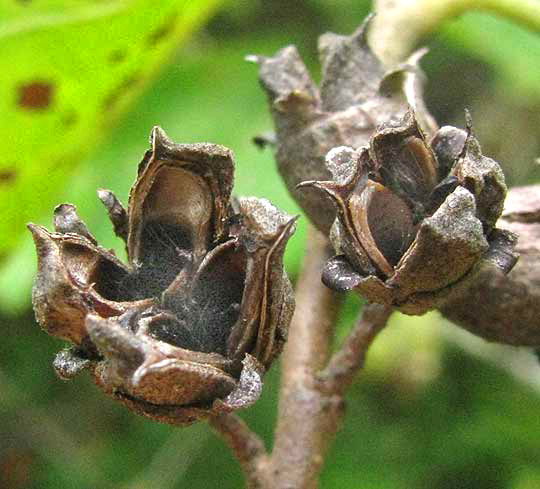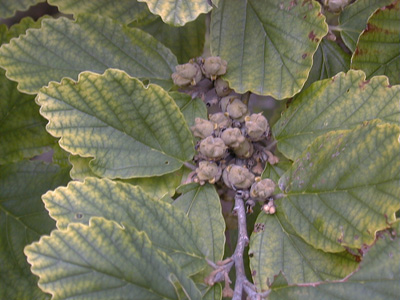A few days ago.
Witchhazel (Hamamelis virginiana) is a large shrub or small tree fairly common to forests in this area, but I've only come across one here in my 'burb. Besides being one of the few familiar plants you can buy an extract* of at the drugstore, witchhazel is unusual in flowering in the fall. Its pale yellow flowers bloom at the "wrong" time of year, when the leaves are falling and cold weather is coming.
I pass this little tree at least daily while walking dogs, and have watched as its buds swelled and and the wavy-edged, slightly-asymmetric leaves yellowed and fell. Yesterday evening I noted that few leaves remained, and wondered when the bush would bloom. Today, a cool, rainy fall day, it has--many buds at once--in the space of a few hours. Because I'd been watching so steadily, I was the more surprised.
Why flower in fall? One hypothesis is that witchhazel is avoiding competition for the flies and bees that seem to be the main pollinators. Also, our witchhazel blooms at a different time than its close relative, Hamamelis vernalis. It is insect pollinated, producing nectar and a faint odor, and is not self-compatible--it can only set fruit with another tree. It is known to be pollinated by a variety of insects. I will watch to see who comes.
Today.
Flowers are borne mostly in close-packed trios.
Four fuzzy sepals unleash four strap-like petals, which part to reveal four stamens
stuffed with sticky pollen.
The wavy-edged leaf with its uneven base makes this small tree easy to identify.
[Forgot to mention another thing about witchhazel: its seed dispersal. Unlike most plants, which disperse their young by wind (think dandelion) or edible fruit, or hitchhiking on animal fur like burs, witchhazel does ballistic seed dispersal: a year after flowering, its capsule, dries out and splits with an audible sound, propelling the seeds up to thirty feet.]

*Drugstore "Witchhazel" is an astringent alcohol extract of witchhazel bark.








No comments:
Post a Comment